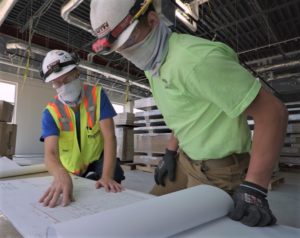12.08.2020
Applying the Hierarchy of Controls to COVID-19 Safety
 In one of my previous blogs, I discussed the use of the Hierarchy of Controls as a risk-reduction strategy by occupational safety and health professionals. Our world has drastically changed since I wrote that blog. In March 2020, the World Health Organization (WHO) declared the COVID-19 disease a pandemic. As of this writing, approximately 55.5 million people have been infected and 1.3 million people have died of the disease worldwide. As a result, organizations have had to adjust their workplace settings and develop guidelines that will protect the safety and health of their employees. The hierarchy of controls can be applied to the COVID-19 pandemic to reduce risk of infection in the workplace; its applications are noted below.
In one of my previous blogs, I discussed the use of the Hierarchy of Controls as a risk-reduction strategy by occupational safety and health professionals. Our world has drastically changed since I wrote that blog. In March 2020, the World Health Organization (WHO) declared the COVID-19 disease a pandemic. As of this writing, approximately 55.5 million people have been infected and 1.3 million people have died of the disease worldwide. As a result, organizations have had to adjust their workplace settings and develop guidelines that will protect the safety and health of their employees. The hierarchy of controls can be applied to the COVID-19 pandemic to reduce risk of infection in the workplace; its applications are noted below.
- Elimination: Elimination is considered the most effective control. It requires physically removing the hazard. In the case of the virus, eliminating it is certainly a difficult task, but can be done by denying access to host cells so that it’s unable to replicate. This could be done by effective vaccinations and prevention of transmission (Spigarelli, 2020). As of this writing, two drug manufacturing companies (Moderna and Pfizer) have announced that their vaccines are more than 90% effective against the coronavirus, and others are in line to follow. Eventually the effectiveness of these and future vaccines can help eliminate the virus; however, we must continue down the hierarchy of controls to continue to protect our workers.
- Substitution: Substitution means replacing the hazard or risk with a less hazardous system. In this situation, it will mean replacing the coronavirus with a virus that is less deadly. A drug could be administered that interferes with the ability of the virus to replicate when a person becomes infected. However, the possibility of substitution will require a great deal of research, money and time (Spigarelli, 2020) and is not currently an effective measure in the hierarchy of controls.
- Engineering Controls: Engineering controls can be developed to isolate people from the hazard, such as installing guards or barriers between people and the hazard. We’ve already seen grocery stores, banks and retail shops install plexiglass screens to prevent the spread of the virus between customers and employees. In a workplace setting, hands-free soap/towel dispensers, trash bins and door openers can prevent the touching of surfaces.
- Administrative Controls: Changing the way people work, limiting people’s exposure by adjusting work tasks or schedules are types of administrative controls. Implementing procedures like maintaining 6 feet of distance between people, frequent and thorough washing of hands, enabling employees to work from home, limiting the size of gatherings and ensuring that employees stay home when sick are examples of administrative control methods. The effectiveness of this control is dependent on how well people comply.
- Personal Protective Equipment (PPE): PPE is used regularly to help protect employees; however, it is considered the least effective of all the controls. In the case of the virus, organizations may require the use of gloves, masks or other face coverings to prevent the spread of the virus. For the use of PPE to be effective, employees must be trained on its proper use and limitations. Even though PPE is considered the least effective control, it has been the main focus during the pandemic because it can be quickly implemented when available (Spigarelli, 2020).
Like most organizations, Faith Technologies’ operations have been impacted by the pandemic. Our company immediately established a task force which was mandated to provide guidance for the company’s response. The task force has relied on guidelines from the Centers for Disease Control (CDC) in establishing policies and procedures to deal with the pandemic, centered around implementing administrative and PPE controls including allowing employees to work from home when possible, maintaining social distancing, routine washing of hands with soap, avoiding or minimizing the size of in-person meetings, requiring employees to stay home when sick, avoiding carpooling and wearing of face coverings/masks as mandated and when 6 feet of separation between employees is not feasible. Faith has also established specific protocols regarding exposure and testing guidelines for all employees which are continually reviewed and updated based on CDC guidelines.
The hierarchy of controls is an effective weapon in the fight against the current pandemic. Elimination or substitution of the virus is yet infeasible, but we can work to contain the virus by implementing a combination of engineering, administrative and PPE controls. These controls, if effectively implemented, will continue to save lives until effective vaccination protocols will eventually help control and eliminate the virus.
References
Spigarelli, C. (2020) Understanding the Hierarchy of Controls Through A Pandemic
If you enjoyed this blog article, please subscribe to stay up to date on the latest industry news from our experts at Faith Technologies.



